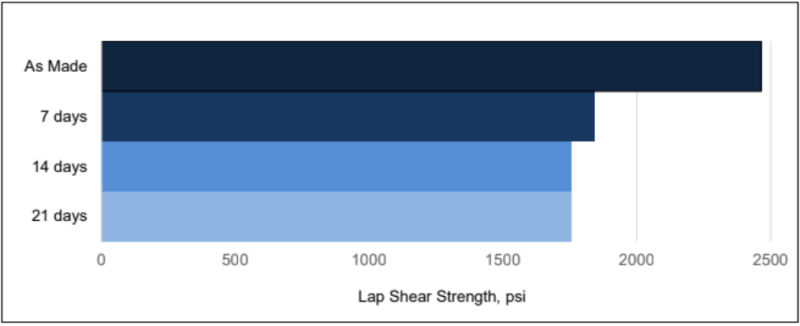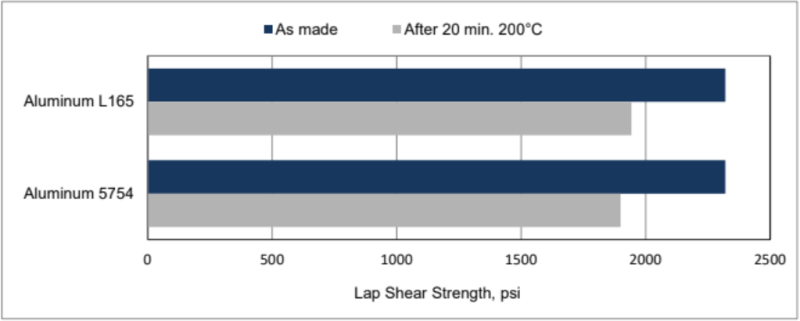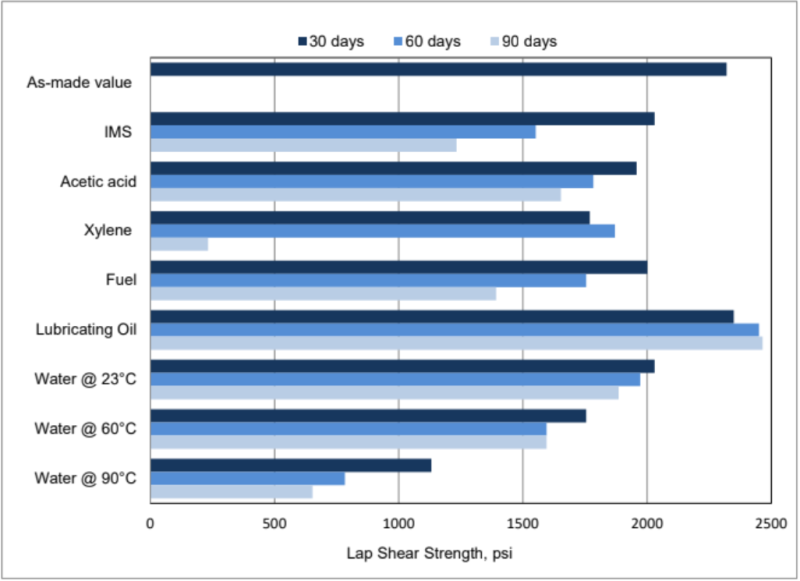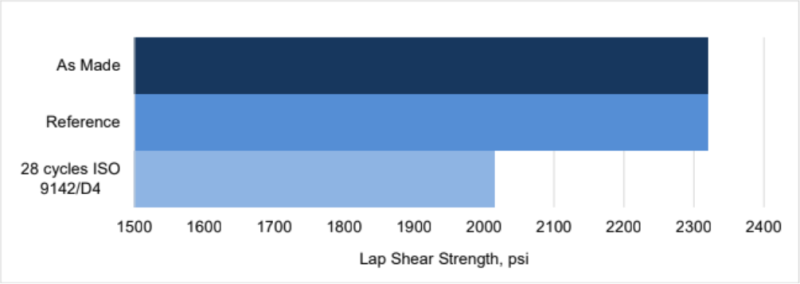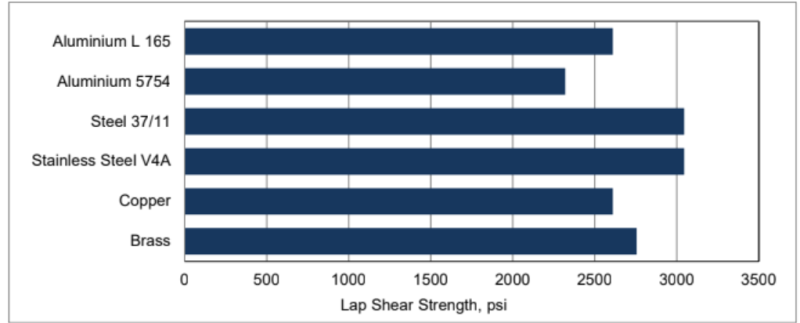Enhanced TDS
Identification & Functionality
- Function
- 2K (2 component) Adhesive,Potting Compound
- RTU Product Type
- Technologies
- Product Families
Features & Benefits
- Labeling Claims
- Ready-to-Use Product Features
- Features and Benefits
- Low odor
- Non-flammable
- High adhesion to various plastics, composites and metals
- Snap-curing
- 10-minute open time
- Product Features
- Low odor
- Non-flammable
- High adhesion to various plastics*, composites and metals
- Snap-curing
- 10-minute open time.
- All-in-one solution for multiple materials
(including plastics). - Exceptional bonding for dissimilar substrates.
- Low odor compared to MMA products.
- Elongation rate of more than 60%
- Exceptional bonding performance.
- Greater workplace productivity
Applications & Uses
- Compatible Substrates & Surfaces
- Application Information
Application of adhesive:
- This system is available in cartridges incorporating mixers and can be applied as ready to use adhesive with the aid of the tool recommended by Huntsman Advanced Materials.
- The resin/hardener mix may be applied manually or robotically to the pretreated and dry joint surfaces.
- A layer of adhesive 0.25 mm thick will normally impart the greatest lap shear strength to the joint.
- The joint components should be assembled and secured in a fixed position as soon as the adhesive has been applied.
- Curing of acrylic polymers and adhesives are inhibited by the presence of atmospheric oxygen.
- In such cases while the bulk material is cured, any exposed surfaces of the adhesive will therefore cure slower than the material in the bondline.
- While acrylic adhesives based on methyl methacrylate rapidly flash off the monomer, to leave a surface that is touch dry; with low odor acrylic adhesives uncured adhesive on exposed surfaces such as on fillets does not evaporate so quickly, this results in a tacky surface.
- Where the requirement for a tack free surface is paramount for example prior to sanding or painting, a standard methyl methacrylate based acrylic adhesive, such as ARALDITE® 2053 adhesive may be used.
- Alternatively, the tacky adhesive surface should be wiped with an MEK impregnated tissue, and the MEK allowed to evaporate to give a dry adhesive surface.
- Warning: the cure reaction can generate a high amount of heat; it is not recommended to mix large amounts of material at room temperature.
Technical Details & Test Data
- Technical Information
Pretreatment :
- The strength and durability of a bonded joint are dependent on proper pretreatment of the surfaces to be bonded; however the methacrylate adhesives can be used effectively with little surface preparation.
- Ideally joint surfaces should be cleaned with a good degreasing agent such as acetone, iso-propanol (for plastics) or other proprietary degreasing agents in order to remove all traces of oil, grease and dirt.
- Low grade alcohol, gasoline (petrol) or paint thinners should never be used.
- The strongest and most durable joints are obtained by either mechanically abrading or chemically etching (“pickling”) the degreased surfaces.
Equipment maintenance :
- All tools should be cleaned with hot water and soap before adhesives residues have had time to cure.
- The removal of cured residues is a difficult and time-consuming operation.
- If solvents such as MEK are used for cleaning, operatives should take the appropriate precautions and, in addition, avoid skin and eye contact.
- Lap shear strength versus Cataplasma Ageing
- Cure: 7 days at RT.
- Substrates sandblasted and degreased with acetone.
- Cataplasma ageing according to ISO 9142/E2 (x days 70°C in soaked cotton / 15 hours -20°C / 24 hours recovery).
- Tested at 73°F.
- Lap shear strength after Coating Post-cure Cycle at 200°C
- Cured 7 days at RT and tested at 23°C.
- Substrates sandblasted and degreased with acetone.
- Ageing with a simulated coating post-cure cycle of 20 minutes at 200°C in an oven.
- Test performed at 23°C.
- Lap shear strength versus immersion in various media (ISO4587)
- On Aluminum L165, pretreatment: sandblasting. Cure: 7 days at RT. Tested at 23°C.
- LSS was determined after immersion for 30, 60, and 90 days at 23°C.
- Lap shear strength versus temperature (ISO 4587)
- Lap shear strength versus temperature (ISO 4587) (typical average values).
- L165 Aluminum substrates sandblasted and degreased with acetone.
- Cured 7 days at RT.
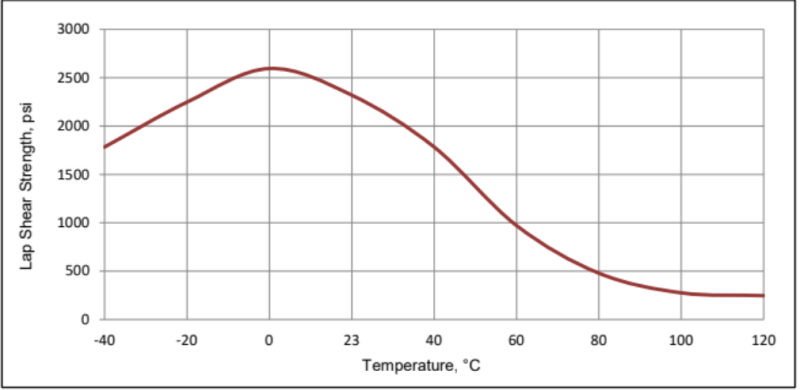
- Average Lap Shear Strengths of Typical Plastic-to-plastic Joints (ISO 4587)
- Cured for 24 hours at RT and tested at 73°F. Substrates abraded and degreased with isopropanol.
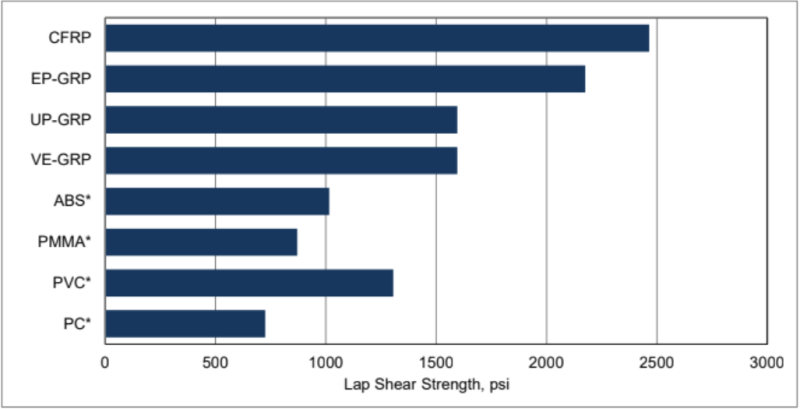
- Lap Shear after Cycling Ageing
- Cure: 7 days at RT. Test at 23°C.
- Substrates sandblasted and degreased with acetone.
- Reference sample: 28 days at 23°C / 50% relative humidity. Humid-heat and cold cycle (-40°C to 70°C at 90% RH) 28 cycles (14 days) according to ISO 9142/D4.
- Average Lap Shear Strengths of Typical Metal-to-metal Joints (ISO 4587)
- Cured for 24 hours at RT and tested at 73°F. Substrates sandblasted and degreased with acetone.
- This data represents typical values only, and do not constitute a product specification.
- Processing Information
Pretreatment
The strength and durability of a bonded joint are dependent on proper pretreatment of the surfaces to be bonded; however the methacrylate adhesives can be used effectively with little surface preparation. Ideally joint surfaces should be cleaned with a good degreasing agent such as acetone, iso-propanol (for plastics) or other proprietary degreasing agents in order to remove all traces of oil, grease and dirt. Low grade alcohol, gasoline (petrol) or paint thinners should never be used. The strongest and most durable joints are obtained by either mechanically abrading or chemically etching (“pickling”) the degreased surfaces.
Application of adhesive
This system is available in cartridges incorporating mixers and can be applied as ready to use adhesive with the aid of the tool recommended by Huntsman Advanced Materials.
The resin/hardener mix may be applied manually or robotically to the pretreated and dry joint surfaces. Huntsman's technical support group can assist the user in the selection of a suitable application method as well as suggest a variety of reputable companies that manufacture and service adhesive dispensing equipment.
A layer of adhesive 0.25 mm thick will normally impart the greatest lap shear strength to the joint. The joint components should be assembled and secured in a fixed position as soon as the adhesive has been applied. Curing of acrylic polymers and adhesives are inhibited by the presence of atmospheric oxygen. In such cases while the bulk material is cured, any exposed surfaces of the adhesive will therefore cure slower than the material in the bondline. While acrylic adhesives based on methyl methacrylate rapidly flash off the monomer, to leave a surface that is touch dry; with low odor acrylic adhesives uncured adhesive on exposed surfaces such as on fillets does not evaporate so quickly, this results in a tacky surface. Where the requirement for a tack free surface is paramount for example prior to sanding or painting, a standard methyl methacrylate based acrylic adhesive, such as ARALDITE® 2053 adhesive may be used.
Alternatively, the tacky adhesive surface should be wiped with an MEK impregnated tissue, and the MEK allowed to evaporate to give a dry adhesive surface.
Warning: the cure reaction can generate a high amount of heat; it is not recommended to mix large amounts of material at room temperature.
Equipment maintenance
All tools should be cleaned with hot water and soap before adhesives residues have had time to cure. The removal of cured residues is a difficult and time-consuming operation. If solvents such as MEK are used for cleaning, operatives should take the appropriate precautions and, in addition, avoid skin and eye contact.
Typical times to minimum shear strength on sandblasted aluminum / contact pressure
Temperature (°C) Cure time (min) to reach LSS > 145 psi (1MPa) Cure time (min) to reach LSS > 1450 psi (10MPa)
23°C <20 <2 Typical Physical Properties
Unless otherwise stated, the figures given below were all determined by testing standard specimens. The figures were determined with typical production batches using standard testing methods. They are provided solely as technical information and do not constitute a product specification. Unless otherwise noted, test specimens were cured for 7 days at room temperature.
Property Test Method Value Glass Transition Temperature DMA 35°C Onset, 65°C Peak
Tensile Strength ISO 527 2466 - 2900 psi Tensile Modulus ISO 527 102 - 131 ksi Elongation at break ISO 527 60-80% T-Peel Strength* ASTM D3167 35 pli *Sandblasted steel
Average lap shear strengths of typical metal-to-metal joints (ISO 4587) (typical average values)
Cured for 24 hours at RT and tested at 73°F. Substrates sandblasted and degreased with acetone. This data represents typical values only, and do not constitute a product specification.
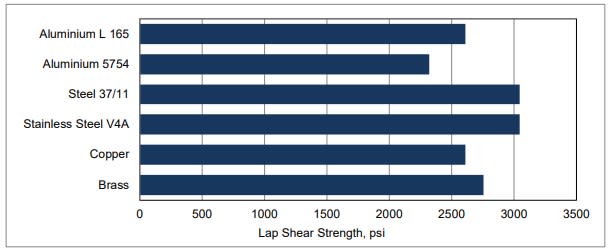
Average lap shear strengths of typical plastic-to-plastic joints (ISO 4587) (typical average values).
Cured for 24 hours at RT and tested at 73°F. Substrates abraded and degreased with isopropanol.
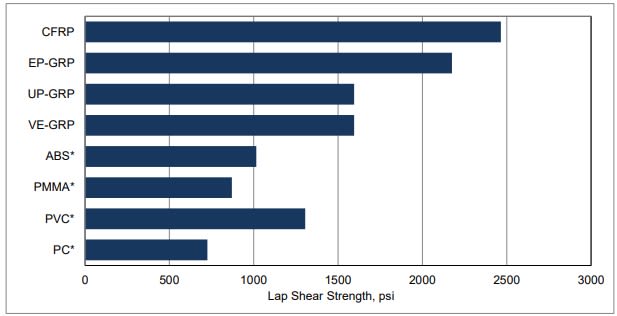
* Substrate failure or substrate’s delamination failure observed.
Lap shear strength versus temperature (ISO 4587) (typical average values).
L165 Aluminum substrates sandblasted and degreased with acetone. Cured 7 days at RT.
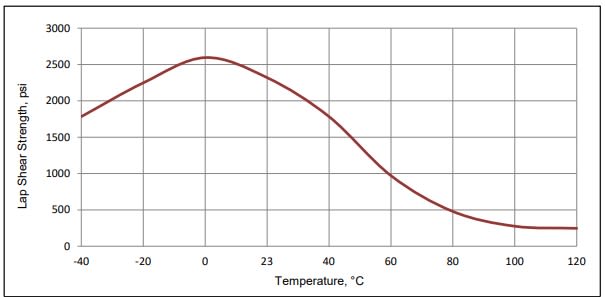
Lap shear after cycling ageing (typical average values)
Cure: 7 days at RT. Test at 23°C. Substrates sandblasted and degreased with acetone. Reference sample: 28 days at 23°C / 50% relative humidity. Humid-heat and cold cycle (-40°C to 70°C at 90% RH) 28 cycles (14 days) according to ISO 9142/D4.
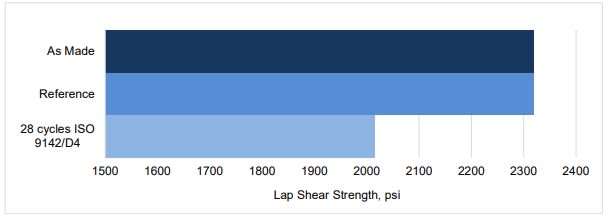
Lap shear strength versus Cataplasma ageing (typical average values)
Cure: 7 days at RT. Substrates sandblasted and degreased with acetone. Cataplasma ageing according to ISO 9142/E2 (x days 70°C in soaked cotton / 15 hours -20°C / 24 hours recovery). Tested at 73°F.
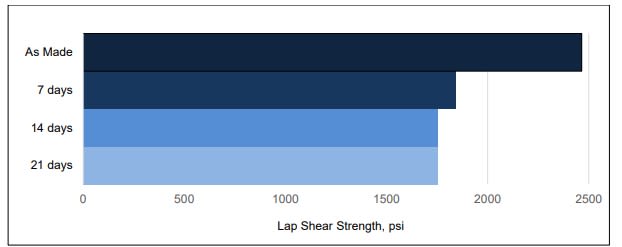
Lap shear strength after coating post-cure cycle at 200°C (typical average values)
Cured 7 days at RT and tested at 23°C. Substrates sandblasted and degreased with acetone. Ageing with a simulated coating post-cure cycle of 20 minutes at 200°C in an oven. Test performed at 23°C.
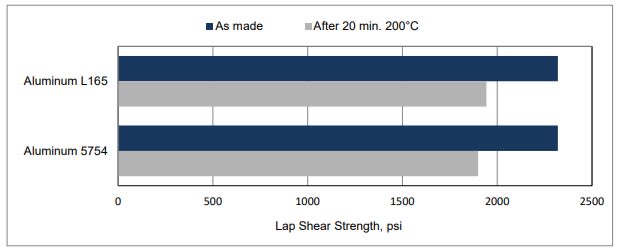
Lap shear strength versus immersion in various media (ISO4587) (typical average values)
On Aluminum L165, pretreatment: sandblasting. Cure: 7 days at RT. Tested at 23°C. LSS was determined after immersion for 30, 60, and 90 days at 23°C.
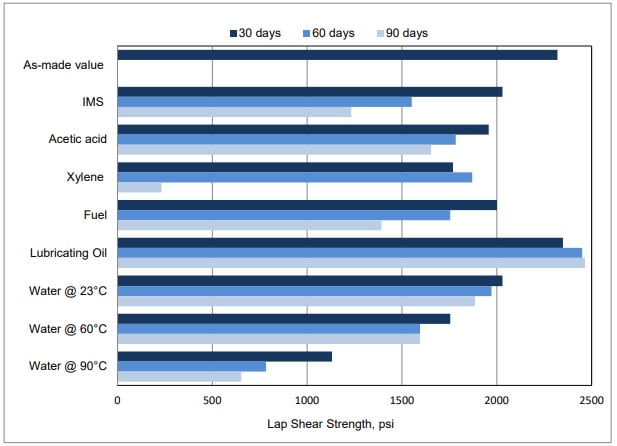
- Technical Graph
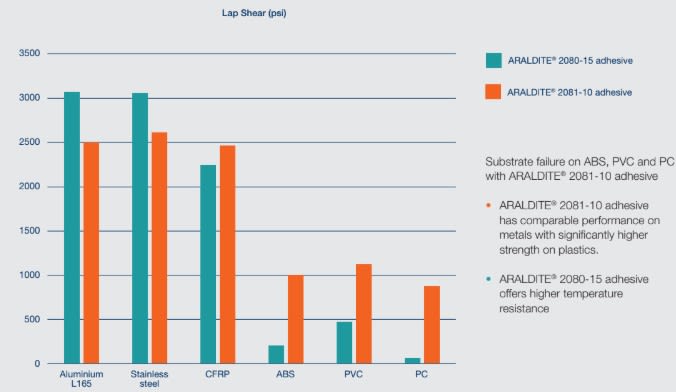
Packaging & Availability
- Regional Availability
Storage & Handling
- Storage Conditions
ARALDITE® 2081-10 A/B should be stored in a dry place, in the original sealed containers, at temperatures between 2°C and 8°C. Under these storage conditions, the product has a shelf life of 24 months (from date of manufacture). The product should not be exposed to direct sunlight. The product may be placed at room temperature before use, but the total time at room temperature should not exceed 9 months. Long term exposure above 25°C will reduce the shelf life of the product.
- Storage Information
- ARALDITE® 2081-10 Structural Adhesive should be stored in a dry place, in the original sealed containers, at temperatures between 2°C and 8°C (36°F and 46°F).
- Under these storage conditions, the product has a shelf life of 24 months (from date of manufacture).
- The product should not be exposed to direct sunlight.
- The product may be placed at room temperature before use, but the total time at room temperature should not exceed 9 months.
- Long term exposure above 25°C (77°F) will reduce the shelf life of the product.
Other
- Application Information
Value Units Test Method / Conditions Fixture Time 20.0 - at room temperature Mix Ratio 0.13 - Hardener : Resin - Mechanical Properties
Value Units Test Method / Conditions Elongation 60.0-80.0 - at Break Tensile Strength min. 2466.0 psi psi - Physical Properties
Value Units Test Method / Conditions Specific Gravity 1.1 - Viscosity 70000.0-90000.0 cPs cPs at 25°C

